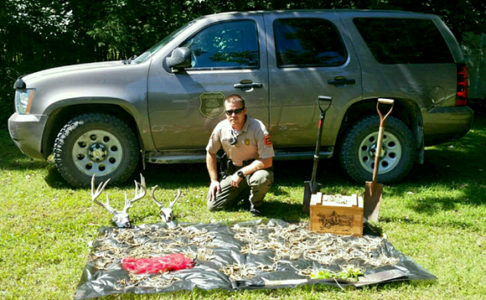
By Mira Braneck
braneckm@grinnell.edu
One plant that is relevant in the black market here in Iowa is not what you may expect: ginseng.
“Ginseng is a slow-growing plant, and its root is used in herbal products, supplements and teas in Asian cultures and health food stores. Most of the ginseng collected in Iowa is exported to countries in Asia, with a small portion going to cities along the west coast, like San Francisco,” Iowa’s Department of Natural Resources (DNR) wrote on its website.
Iowa is one of 19 states in the U.S. that allows legal ginseng harvest. Much of the ginseng harvested in the US is exported to China and Korea, and growing markets in both countries have caused a major increase in the profitability in ginseng, according to an article published by The Gazette.
The price of ginseng depends on the strength of these economies, according to the DNR’s website. Last year, on average, ginseng sold for 500 to 600 dollars per pound, with particularly high quality ginseng fetching up to 750 dollars per pound.
Iowa exports more than 1,000 pounds of dried ginseng roots per year, according to The Gazette. This amounts to anywhere between 125,000 and 150,000 ginseng plants.
There are very strict and specific laws concerning the harvest and growth of ginseng. One must obtain a variety of permits, and only harvest plants of a certain maturity. The plant must have three or more leaves or prongs, as well as a flowering or fruiting stalk with red berries, according to the DNR’s website.
In order to harvest wild ginseng, one must obtain an Iowa Ginseng Harvester permit through the DNR, which manages both the harvest and export of ginseng. These cost 37 dollars, and there are currently 154 individuals with these permits in Iowa. To grow ginseng, one must obtain an Iowa’s Grower permit, which are valid for five years. Iowa Ginseng Dealer permits are necessary to buy ginseng. Dealers are required to file monthly and annual reports. Iowa Ginseng Dealer permits are valid for a year, from April 1 to March 31, according to the DNR’s website.
Wild ginseng, according to the DNR, is classified as any unprocessed part of the ginseng plant, which is growing or has been harvested from its native habitat. Cultivated ginseng, on the other hand, indicates that the plant was nurtured or grown in a controlled setting.
The ginseng harvest seasons spans from Sept. 1 to Oct. 31. For the rest of the year, no one can harvest ginseng, whether it is harvested or cultivated, even on private land.
After harvesting wild ginseng, one must plant all seeds that were collected from the plant within 100 feet of the parent plant. There are also specific methods in which one must plant the seeds, as dictated by the DNR website. It is illegal to take these seeds when found, as well as sell them.
It is illegal to harvest ginseng from any state-owned or managed land. In fact, three men were arrested over Labor Day weekend of this year for illegally harvesting ginseng from state-managed lands.
All three had valid harvesting permits and were within the legal two-month long harvest season; however, they were harvesting from an area in which it is illegal to do so. The DNR asked for the equivalent of 150 percent of the value of the ginseng that was illegally harvested, which amounts to 292.50 dollars from each individual, according to the DNR’s website.
So while ginseng harvesting may seem like a lucrative post-grad plan, entrepreneurial Grinnellians should make sure to learn the letter of the law before trying their hand at the trade.



































































